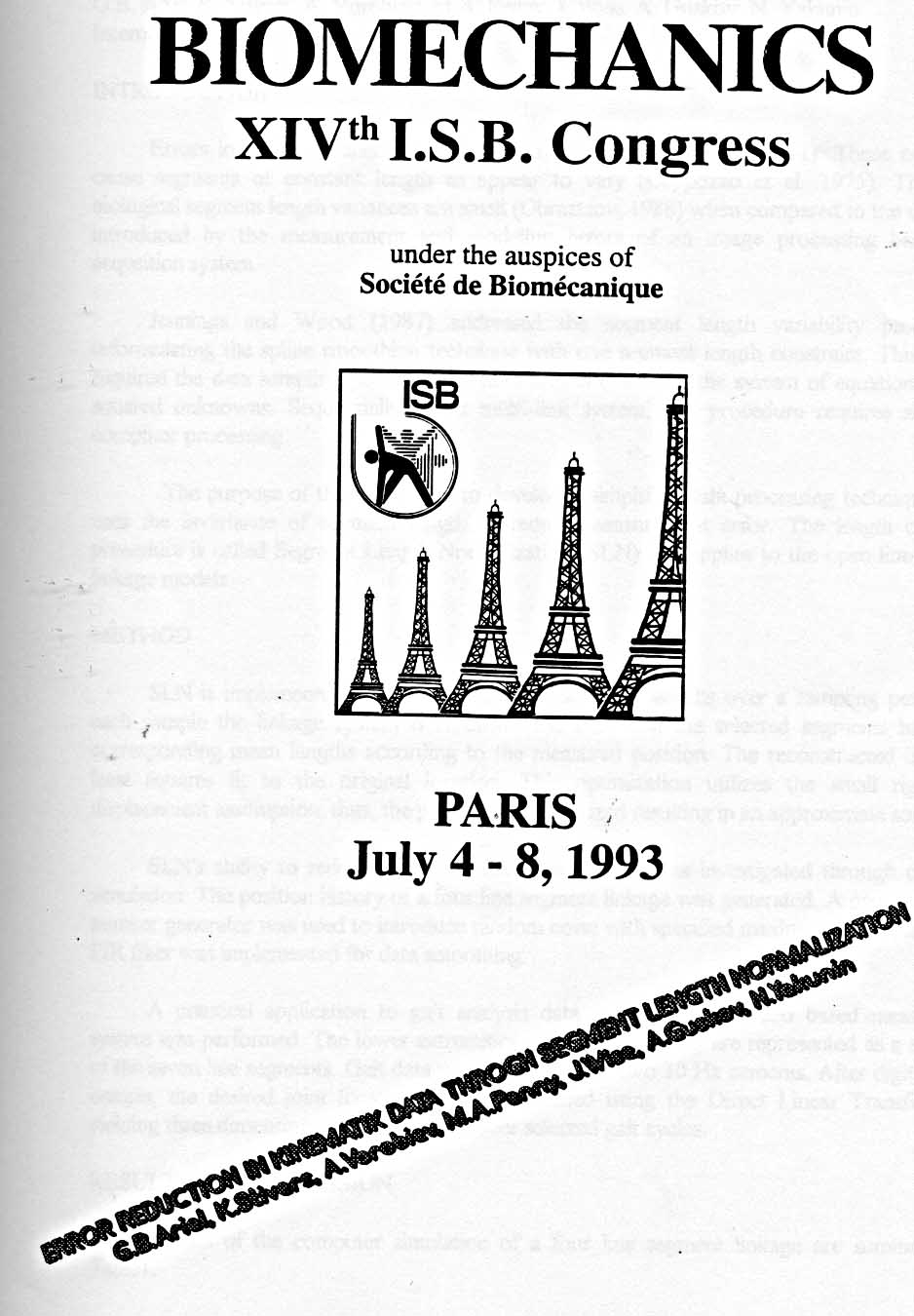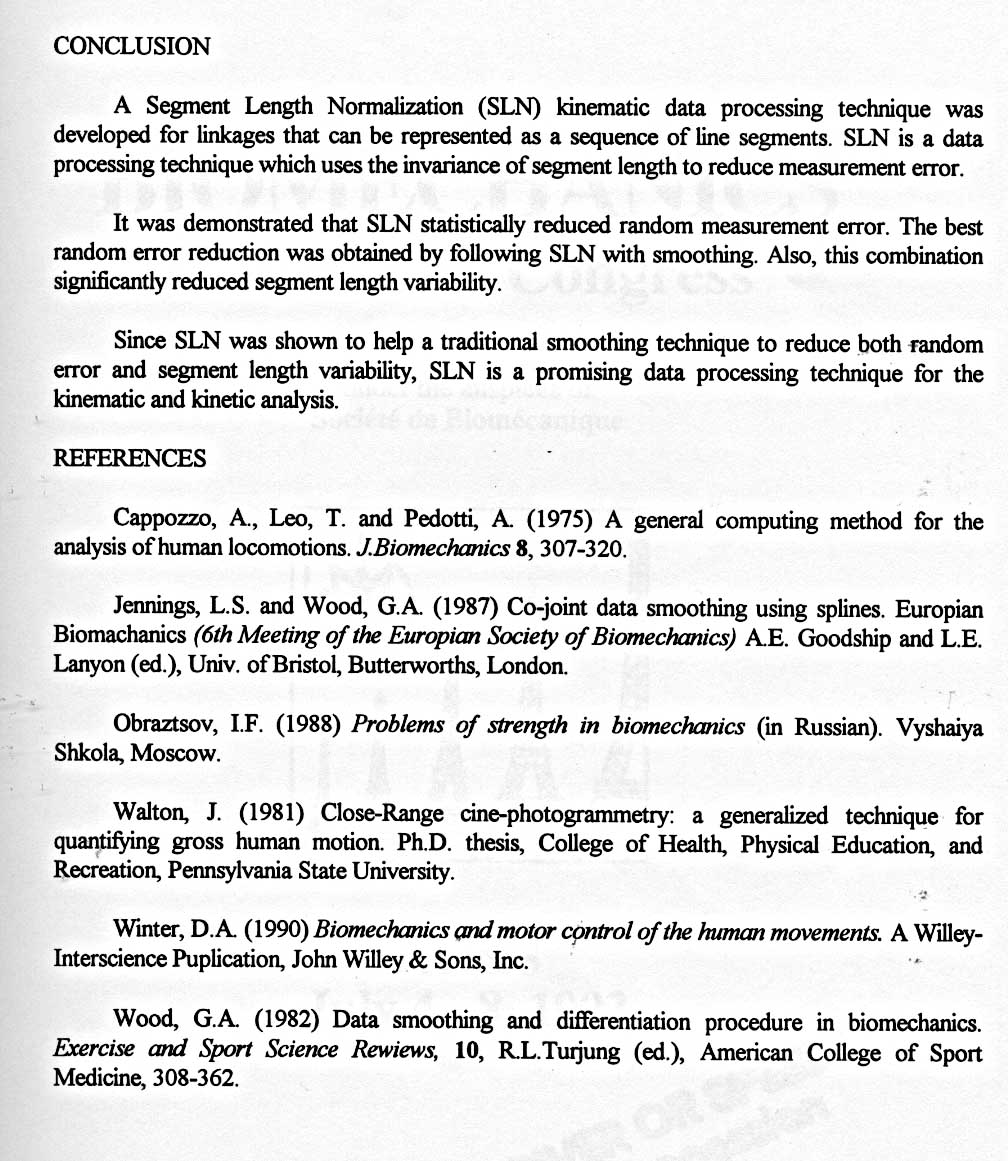Error Reduction in Kinematic Data through Segment Length Normalization
A simplified data processing technique using the invariance of segment length to reduce measurement error
By Gideon Ariel in ISB on Tuesday, July 6, 1993
Article Synopsis
The article titled "Error Reduction in Kinematic Data through Segment Length Normalization" by G.B. Ariel, K. Stivers, A Vorobiev, M.A Penny, J. Wise, A Guskov, N. Yakunin, discusses a new data processing technique called Segment Length Normalization (SLN) developed to reduce measurement errors in kinematic data. The technique uses the invariance of segment length to minimize errors. The study found that SLN statistically reduced random measurement error and the best results were obtained when SLN was followed by a smoothing procedure. This combination also significantly reduced segment length variability. The authors conclude that SLN is a promising data processing technique for kinematic and kinetic analysis.
Tip: use the left and right arrow keys
BIOMECHANICS
XI V'"I.S.B. Congress
under the auspices of
Societe de Biomecanique
PARIS -
July 4 - 8, 1993
ERROR REDUCTION IN KINEMATIC DATA THROUGH SEGMENT LENGTH NORMALIZATION
G.B. Ariel, K. Stivers, A Vorobiev, M.A Penny, J. Wise, A Guskov, N. Yakunin International Center for Biomechanical Research, La Jolla, USA
INTRODUCTION
Errors in acquired kinematic data have many causes (Walton, 1981). These errors can cause segments of constant length to appear to vary (Cappozzo et al. 1975). The actual biological segment length variances are small (Obraztsov, 1988) when compared to the variability introduced by the measurement and modeling errors of an image processing based data acqusition system.
Jennings and Wood (1987) addressed the segment length variability problem by reformulating the spline smoothing technique with one segment length constraint. This method required the data sampling process of N measurements solving the system of equations with N squared unknowns. Sequentially, for a multi-link system, this procedure requires significant computer processing.
The purpose of this study was to develop a simplified data processing technique which uses the invariance of segment length to reduce measurement error. The length constraint procedure is called Segment Length Normalization (SIN) and applies to the open line-segment linkage models.
METHOD
SLN is implemented by determining mean segment lengths over a sampling period. For each sample the linkage system is reconstructed such that the selected segments have -their corresponding mean lengths according to the measured position. The reconstructed linkage is least squares fit to the original location. This optimization utilizes the small rigid body displacement assumption; thus, the procedure is linearized resulting in an approximate solution.
SLNs ability to reduce random measurement error was investigated through computer simulation. The position history of a four line segment linkage was generated. A pseudo random number generator was used to introduce random noise with specified maximum error magnitude. FIR filter was implemented for data smoothing.
A practical application to gait analysis data acquired from video based measurement system was performed. The lower extremities of the human body are represented as a sequence of the seven line segments. Gait data was obtained from two 30 Hz cameras. After digitizing the images, the desired joint locations were determined using the Direct Linear Transformation yielding three dimensional point locations over selected gait cycles.
RESULTS AND DISCUSSION
Results of the computer simulation of a four line segment linkage are summarized in Tablel.
Table 1.
RMS Position Error
S rand.max E raw E smooth E SIN E SIN+smooth
[%] [%] [%] [%] [%]
1.0 .71 .46 .66 .42
3.0 1.89 1.17 1.71 1.07
5.0 2.99 1.85 2.74 1.69
7.0 4.19 2.6 3.85 2.39
_ 5.35 3.31 4.96 3.06
9.0
11.0 6.43 3.97 5.96 3.66
13.0 7.65 4.69 7.32 4.52
15.0 9.03 5.48 8.50 5.20
Error is expressed as a percentage of total linkage length. By forcing relationships between the points connected in the open linkage system, SLN reduced measurement error by tending to correct each instantaneous segment length to it's average length. As can be seen in Table 1, the SLN procedure reduced random error on the average by 7.33% with standard deviation 1.65%.
After determination of the mean lengths, SLN treats each instant separately; thus, SLN is a stochastic procedure which does not necessarily have desirable spectral effects. Therefore, SLN should always be followed by a smoothing procedure. The FIR filter used in both the simulation and gait application is a three point filter with coefficients .25, .5, .25. The filter reduces random error by 38.00�0.92%. The best results were achieved by following SLN with the filter. This combination decreased random error by 42.45�1.08% which is a 7.0�1.76% improvement over only filtering. Further study of the spectral effects of SLN is warranted.
Segment length variability can negatively effect the results of a kinetic analysis. The problems stem from the prevailing methods of detetmining inertial properties from segment length. Since minimal segment length variability is desirable, an investigation of each considered technique's effect on segment variability is informative. Root mean squared length variability for the linkage was calculated for gait analysis data. Results are presented in Table 2.
Table 2.
Segment Length Variability
L raw L smooth L SLN L sLN+smooth
RMS variability 2.37 2.35 .13 .21
x I OE-2 [m]
variability reduction - .96 94.64 91.22
relative to raw [%] _
The SLN method followed with smoothing reduced length variability by 91.22% which is 91.13% less than the length variability corresponding to only smoothing.
CONCLUSION
A Segment Length Normalization (SLN) kinematic data processing technique was developed for linkages that can be represented as a sequence of line segments. SLN is a data processing technique which uses the invariance of segment length to reduce measurement error.
It was demonstrated that SLN statistically reduced random measurement error. The best random error reduction was obtained by following SLN with smoothing. Also, this combination significantly reduced segment length variability.
Since SLN was shown to help a traditional smoothing technique to reduce both random error and segment length variability, SLN is a promising data processing technique for the kinematic and kinetic analysis.
REFERENCES
Cappozzo, A., Leo, T. and Pedotti, A (1975) A general computing method for the analysis of human locomotion. J.Biomech nics 8, 307-320.
Jennings, L. S. and Wood, G. A. (1987) Co-joint data smoothing using splines. Europian Biomachanics (6th Meeting of the Europian Society of Biomechanics) A.E. Goodship and L.E. Lanyon (ed.), Univ. of Bristol, Butterworths, London.
Obraztsov, I.F. (1988) Problems of strength in biomechanics (in Russian). Vyshaiya Shkola, Moscow.
Walton, J. (1981) Close-Range cine-photogrammetry: a generalized technique for quantifying gross human motion. Ph.D. thesis, College of Health, Physical Education, and Recreation, Pennsylvania State University.
Winter, D.A (1990) Biomechanics and motor control of the human movements A WilleyInterscience Puplication, John Willey & Sons, Inc.
Wood, G.A (1982) Data smoothing and differentiation procedure in biomechanics. Exercise and Sport Science Rewiews, 10, RL.Turjung (ed.), American College of Sport Medicine, 308-362.




